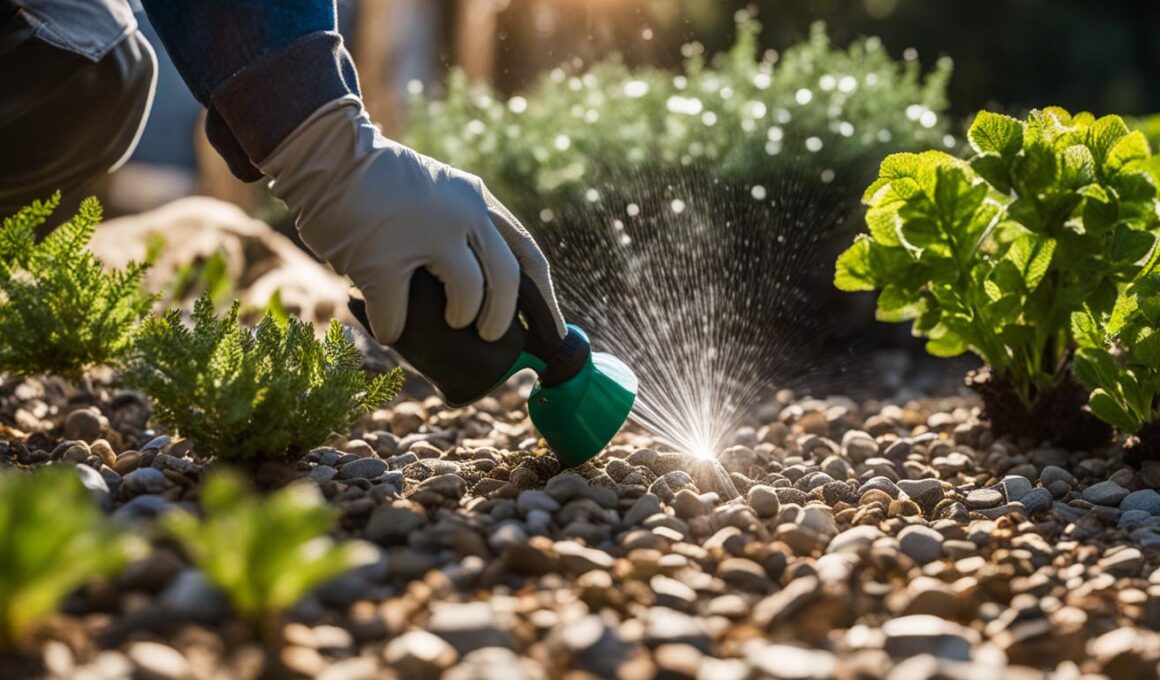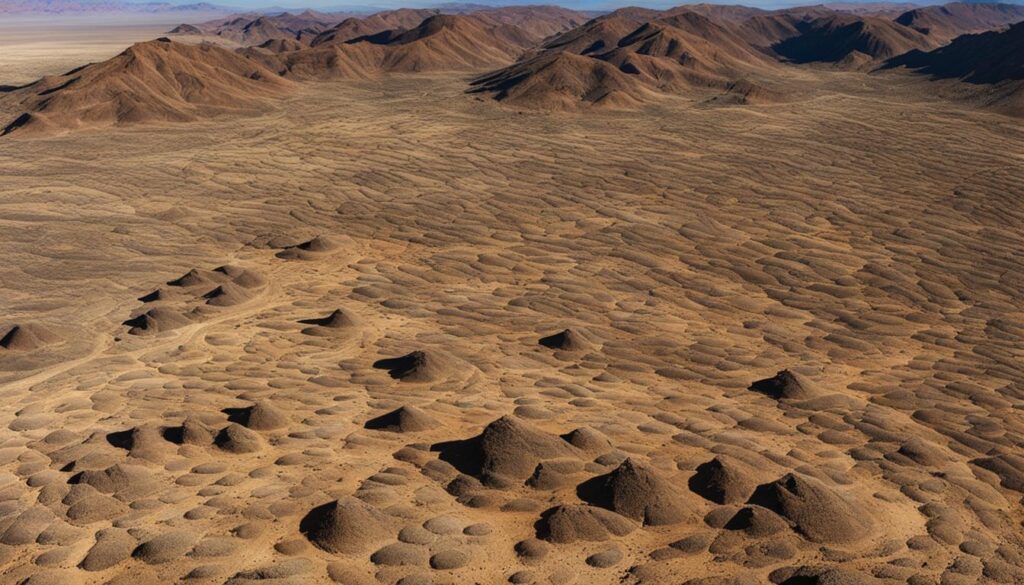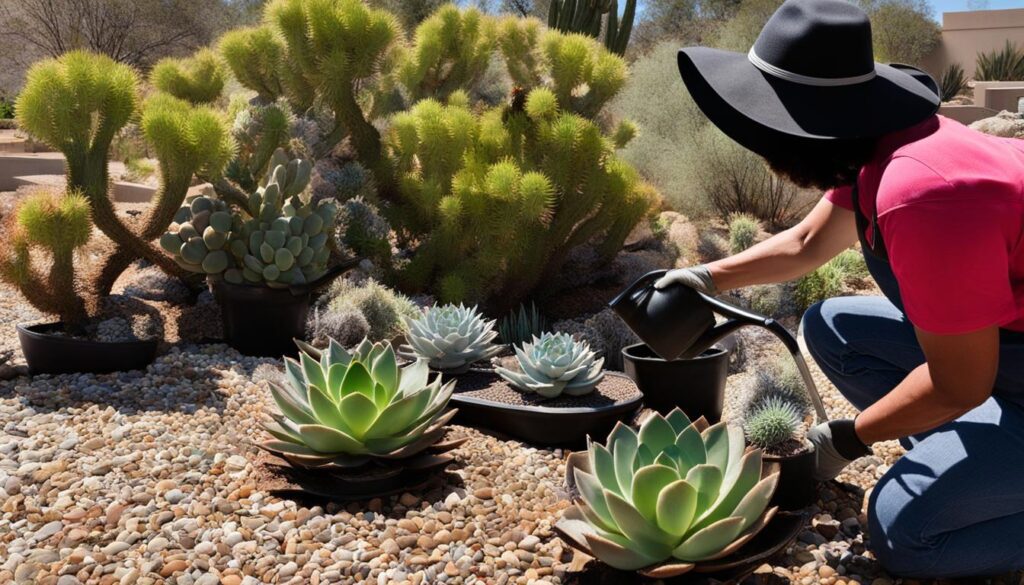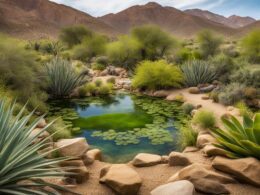Xeriscaping is an efficient way to conserve water by using drought-tolerant plants and grasses in landscaping. It doesn’t require filling your yard with rocks and cactus, but rather focuses on using native plants and hardscaping. Denver Water Department coined the term “xeriscape” in 1981 to promote water conservation. Xeriscaping can reduce water bills by 60% or more, create natural habitats for wildlife, and increase property value. It also eliminates the need for mowing, herbicides, and fertilizers, making it environmentally friendly.
Key Takeaways:
- Xeriscaping involves using drought-tolerant plants and grasses to conserve water in landscaping.
- Native plants and hardscaping are key components of xeriscaping.
- Xeriscaping can reduce water bills, create wildlife habitats, and increase property value.
- It eliminates the need for mowing, herbicides, and fertilizers, making it environmentally friendly.
- Proper xeriscape maintenance can lead to a beautiful and low-maintenance yard.
Benefits of Xeriscaping
Xeriscaping offers a multitude of benefits that make it an attractive choice for homeowners. One of the most significant advantages is the substantial water savings it provides. By using drought-tolerant plants, xeriscaping minimizes the need for additional watering beyond natural rainfall. This results in lower water bills and helps conserve this valuable resource for future generations. According to studies, xeriscaping can reduce water usage by up to 60% or more. So not only does it benefit your wallet, but also the environment.
Another key benefit of xeriscaping is the cost savings it brings. With traditional landscaping, there is a constant need for irrigation systems, mowing equipment, and the use of chemicals such as pesticides, herbicides, and fertilizers. Xeriscaping eliminates or greatly reduces the need for these expenses, resulting in long-term cost savings. Additionally, the low maintenance nature of xeriscaped yards means less time and effort spent on upkeep, allowing homeowners to enjoy their beautiful landscape without the hassle.
“Xeriscaping is not just about saving water, it’s about creating a sustainable and environmentally friendly landscape.”
Environmental protection is another significant advantage of xeriscaping. By eliminating the use of harmful chemicals, xeriscaped yards contribute to a healthier ecosystem. The absence of pesticides, herbicides, and fertilizers not only protects the environment from pollution, but also creates a safe habitat for beneficial insects, birds, and other wildlife. Xeriscaping promotes biodiversity and sustainability by using native plants that are adapted to the local climate and require minimal artificial interventions, reducing the overall ecological footprint of landscaping practices.
In summary, xeriscaping offers homeowners numerous benefits, including water and cost savings, low maintenance requirements, and environmental protection. By implementing xeriscaping techniques, you can create a beautiful and sustainable landscape that not only enhances the value of your property but also contributes to a more eco-friendly future.
Designing Your Xeriscape Yard
When it comes to designing your xeriscape yard, several factors should be considered to create a sustainable and visually appealing landscape. Here are some important considerations:
Soil Considerations
Understanding your soil type is crucial for selecting the right plants for your xeriscape yard. Different plants have different soil requirements, so it’s important to test your soil’s pH level and composition. Sandy soils drain quickly, whereas clay soils retain more moisture. Amending the soil with organic matter can improve its water-holding capacity.
Sun Exposure
The amount of sunlight your yard receives is another important factor in plant selection. Some plants thrive in full sun, while others prefer partial shade. Observe the sun patterns in your yard throughout the day to determine which areas receive the most sun and which are shaded. This will help you choose the right plants and ensure their optimal growth.
Slopes
If your yard has slopes, it’s important to consider the water runoff and erosion potential. Slopes can cause water to drain quickly, potentially leaving your plants dry. Consider terracing or creating swales to slow down the flow of water and allow it to penetrate the soil. Planting drought-resistant plants higher on slopes can also help them benefit from runoff water.
Companion Planting
Companion planting involves grouping plants with similar water and sunlight requirements to optimize water usage and create a harmonious garden. Some plants thrive together and can provide shade and shelter for each other. By carefully selecting and arranging your plants, you can create a visually appealing and functional xeriscape yard.
Choosing Drought-Tolerant Plants
Xeriscaping allows for a wide variety of plants that thrive with little water. By selecting the right plants for your xeriscape yard, you can create a beautiful and sustainable landscape. Native plants are a popular choice as they are well adapted to the local climate and require minimal maintenance once established. They have evolved to survive in the region’s specific soil and weather conditions, making them naturally drought-tolerant.
Benefits of Native Plants:
- Require less water:
- Low maintenance:
- Support local ecosystems:
Native plants have deep root systems that can access water deep within the soil, reducing the need for additional watering.
Once established, native plants are more resistant to pests and diseases, reducing the need for chemical treatments. They also require less pruning and fertilization.
Native plants provide food and habitat for native wildlife, including birds, butterflies, and beneficial insects.
Aside from native plants, there are many other drought-tolerant options that can enhance the beauty of your xeriscape yard. These include coneflowers, marigolds, lavender, daffodils, iris, sedum, coreopsis, and verbena, to name a few. When selecting plants, consider their water needs, growth habits, and color to create an aesthetically pleasing and diverse landscape.
Remember, even drought-tolerant plants may need occasional watering, especially during periods of extreme drought. To minimize water usage, consider installing a drip irrigation system. This method delivers water directly to the plant’s roots, reducing evaporation and ensuring efficient water distribution.
What are the essential maintenance tasks for xeriscaping that beginners should know?
When starting out with xeriscaping, it’s important to follow a xeriscape landscape maintenance checklist to keep your garden healthy. Tasks like watering efficiently, mulching, and regular weeding are essential. Proper soil management and planning for weather changes are also key to a successful xeriscape garden.
Maintaining Your Xeriscape Yard
Maintaining a xeriscape yard requires specific attention and care to ensure its longevity and beauty. Here are some essential maintenance tasks to keep in mind:
- Watering: Proper watering is crucial for the health of your xeriscape plants. Deep and infrequent watering encourages deep root growth and reduces water evaporation. Consider using a drip irrigation system for efficient and targeted watering.
- Fertilizing: While xeriscape plants generally require less fertilization, occasional feeding can help promote healthy growth. Follow the product label recommendations and choose organic, slow-release fertilizers to minimize environmental impact.
- Weed Control: To prevent weeds from competing with your xeriscape plants for water and nutrients, regular weed control is necessary. Apply mulch or use natural weed control methods to keep your yard free from unwanted vegetation.
- Pruning: Proper pruning techniques are essential to maintain the shape and health of your xeriscape plants. Refer to specific guidelines for each plant type to ensure you prune at the right time and in the correct manner.
- Lawn Mowing: If you have a xeriscape lawn, ensure that you mow it at the correct intervals and heights. Mowing too frequently or too short can stress the grass and make it more susceptible to weed invasion.
By staying diligent with these maintenance tasks, you can keep your xeriscape yard thriving and looking its best.
Conclusion
Xeriscape maintenance offers a practical and eco-friendly approach to landscaping. By implementing water-conserving techniques and using drought-tolerant plants, you can significantly reduce water usage while creating a beautiful and low-maintenance landscape. Xeriscaping not only benefits your wallet with cost savings on water bills and maintenance, but it also plays a crucial role in water conservation.
By eliminating the need for excessive watering, mowing, fertilizers, and pesticides, you contribute to the preservation of our precious water resources and protect the environment from harmful chemicals. Xeriscaping is a sustainable and efficient gardening practice that promotes water conservation and supports the health of our ecosystems.
With proper planning and design, your xeriscape yard can be visually appealing while requiring minimal upkeep. By selecting the right plants for your region, considering soil type, sun exposure, and slopes, you can create a thriving and resilient xeriscape garden. Embracing xeriscape maintenance is not only a responsible choice, but it also allows you to enjoy a beautiful and sustainable landscape for years to come.













